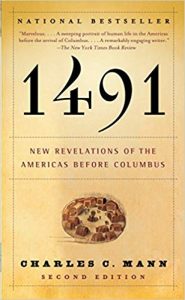I read the “sequel” – “1493” a couple years ago, so I was looking forward to this book. I was disappointed at first. The book drags in the first parts. There was too much detail of history that was precise beyond the available data and too much personalized accounts of the authors explorations.
His strength is ecological history and the author does well in the last chapters talking about anthropomorphic landscapes. For example, he talks about the terra preta land in the Amazon, which human created soil.
The big idea is that landscapes in the Americas were not untouched by humans, but rather the creation of humans over the centuries. This includes the wild Amazon. It was a different sort of agriculture, sort of a natural gardening with many species of trees and roots.
Where no man had gone before
When Europeans arrived, they thought they found a virgin landscape. They were mistaken. Native Americans had altered the landscape for thousands of year though their hunting and especially the use of fire.
European settlers also came upon a “widowed” landscape, not a virgin one. Disease killed the native population often before the arrival of Europeans. Natives had burned and used the forests, hunted and controlled game. When large numbers of natives were eliminated by disease, the forests grew thicker and animals proliferated. Large herds of bison, elk, deer, thick forests and flocks of passenger pigeons that Europeans found represented rebounding populations, not the previous situation.
Meaning for the land ethic
This is a sign of hope and helps in the understanding of a regenerative land ethic. Following a land ethic, we seek to live in harmony with nature. Harmony specifically does NOT mean apart or not interacting. In our context, it means means neither dominating nature nor mimicking it nor setting it apart to “save” it, but rather trying to understand and use natural principles. Similarly, we should not try to mimic the techniques of the past nor try to restore what was. We can use these methods & principles of the past and make a once and future way to manage our land.

